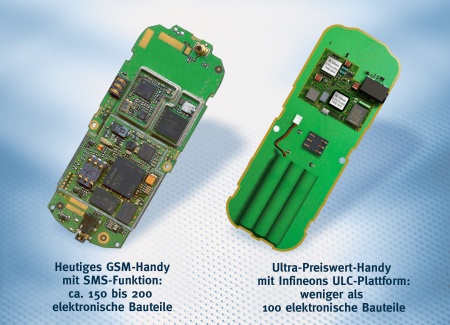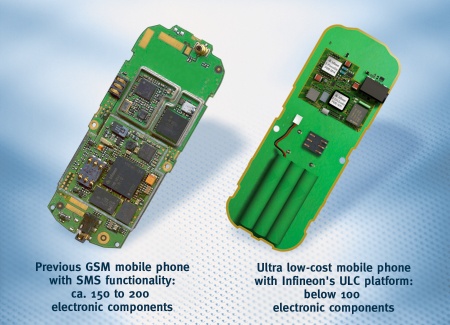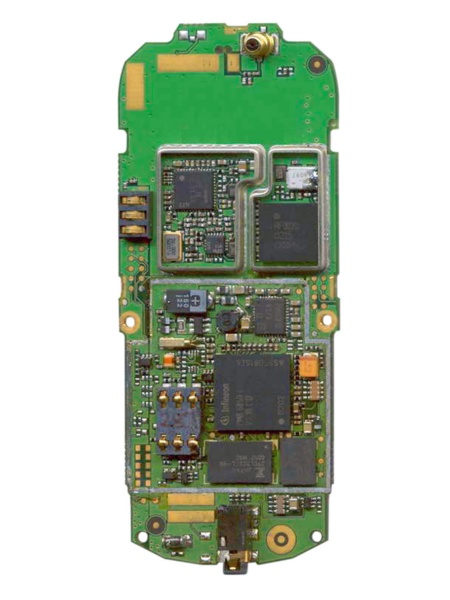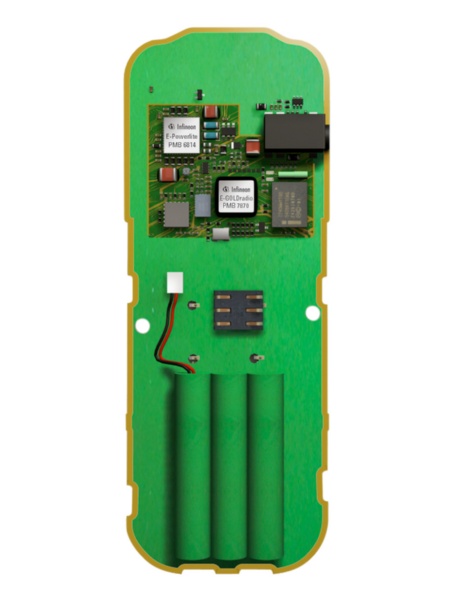Ultra-High-Tech for Ultra Low-Cost Handsets Available: Infineon Introduces Chip Platform for Sub-$20 Mobile Handsets in Production
Munich, Germany - July 13, 2005 - Around 3.5 billion people now living in areas with mobile phone coverage cannot afford their own mobile phone. But this could soon change. With a chip platform for ultra low-cost handsets, Munich-based semiconductor manufacturer Infineon Technologies AG (FSE/NYSE: IFX) has laid the foundation for mass production of very low-cost mobile phones. The production costs for such mobile phones could be cut by nearly one half in future, from the current figure of around US $35 to below US $20. These costs include the complete mobile phone with its keypad, display and charging system, software for ensuring ease of use with the SMS and phone functions, packaging and documentation. Infineons platform is ready to release to handset manufacturers as a reference platform for new product designs, which means that ultra low-cost handsets could be planned for volume production in the first half of 2006.
With Infineons new platform design, a mobile phone capable of basic voice and SMS service needs below one hundred electronic components, in contrast to the 150 to approximately 200 components required in models produced today. This is made possible by a highly integrated chip of Infineon that combines the processor and the send and receive electronics. The use of this single-chip means that numerous capacitors, filters and resistors are not needed and that the entire electronics package is just one-third the size of current designs, taking up just about 3 centimeters on 3 centimeters.
As a result, there is enough room in a typical size handset casing for a number of standard rechargeable batteries - such as nickel metal hydride (NiMH) AAA micro-cells. Infineon estimates that an ultra low-cost handset equipped with todays typical rechargeable mobile phone batteries would have a standby time of more than ten days and talk-time of more than four hours.
Worldwide, there are currently about 1.8 billion mobile phone users. The demand for low-cost and easy-to-operate mobile phones with SMS functionality is increasing. Many people want to enjoy the benefits of mobile communications, but place little value on applications such as camera and video features, web browser, music player and games.
The US market-research company Strategy Analytics expects that more than 150 million ultra low-cost handsets, costing less than US $50 wholesale, will be sold throughout the world in 2010.
Infineon aims to provide the mobile phone manufacturers with chips for individual functions, and also with complete reference platforms for all types of mobile phone - ranging from ultra low-cost phones to multi-functional multimedia ones. Infineon is one of the worlds leading suppliers of mobile phone platforms. These are adapted by mobile phone manufacturers to their individual designs, and can therefore shorten development times and reduce production costs.
With Infineons new platform design, a mobile phone capable of basic voice and SMS service needs below one hundred electronic components, in contrast to the 150 to approximately 200 components required in models produced today. This is made possible by a highly integrated chip of Infineon that combines the processor and the send and receive electronics. The use of this single-chip means that numerous capacitors, filters and resistors are not needed and that the entire electronics package is just one-third the size of current designs, taking up just about 3 centimeters on 3 centimeters.
As a result, there is enough room in a typical size handset casing for a number of standard rechargeable batteries - such as nickel metal hydride (NiMH) AAA micro-cells. Infineon estimates that an ultra low-cost handset equipped with todays typical rechargeable mobile phone batteries would have a standby time of more than ten days and talk-time of more than four hours.
Worldwide, there are currently about 1.8 billion mobile phone users. The demand for low-cost and easy-to-operate mobile phones with SMS functionality is increasing. Many people want to enjoy the benefits of mobile communications, but place little value on applications such as camera and video features, web browser, music player and games.
The US market-research company Strategy Analytics expects that more than 150 million ultra low-cost handsets, costing less than US $50 wholesale, will be sold throughout the world in 2010.
Infineon aims to provide the mobile phone manufacturers with chips for individual functions, and also with complete reference platforms for all types of mobile phone - ranging from ultra low-cost phones to multi-functional multimedia ones. Infineon is one of the worlds leading suppliers of mobile phone platforms. These are adapted by mobile phone manufacturers to their individual designs, and can therefore shorten development times and reduce production costs.
About Infineon
Infineon Technologies AG, Munich, Germany, offers semiconductor and system solutions for automotive, industrial and multimarket sectors, for applications in communication, as well as memory products. With a global presence, Infineon operates through its subsidiaries in the US from San Jose, CA, in the Asia-Pacific region from Singapore and in Japan from Tokyo. In fiscal year 2004 (ending September), the company achieved sales of Euro 7.19 billion with about 35,600 employees worldwide. Infineon is listed on the DAX index of the Frankfurt Stock Exchange and on the New York Stock Exchange (ticker symbol: IFX). Further information is available at
www.infineon.com.
Information Number
INFCOM200507.069
Press Photos
-
 Mit Infineons neuer Referenz-Plattform ULC verringert sich die Anzahl der elektronischen Bauteile im GSM-Handy mit SMS-Funktion von heute ca. 150 bis 200 auf weniger als 100.ULC old platform (German)
Mit Infineons neuer Referenz-Plattform ULC verringert sich die Anzahl der elektronischen Bauteile im GSM-Handy mit SMS-Funktion von heute ca. 150 bis 200 auf weniger als 100.ULC old platform (German)JPG | 997 kb | 2126 x 1535 px
ULC old platform (German)JPG | 26 kb | 222 x 160 px
-
 With Infineon's ULC mobile phone platform the number of electronic components needed in a GSM mobile phone with SMS functionality is reduced to below 100, from around 150 to approximately 200 today.ULC old platform (English)
With Infineon's ULC mobile phone platform the number of electronic components needed in a GSM mobile phone with SMS functionality is reduced to below 100, from around 150 to approximately 200 today.ULC old platform (English)JPG | 991 kb | 2126 x 1535 px
ULC old platform (English)JPG | 26 kb | 222 x 160 px
-
 Today's simple GSM mobile phone with SMS functionality needs around 150 to approximately 200 electronic components.Old platform standalone
Today's simple GSM mobile phone with SMS functionality needs around 150 to approximately 200 electronic components.Old platform standaloneJPG | 241 kb | 911 x 1215 px
Old platform standaloneJPG | 16 kb | 120 x 160 px
-
 With Infineon's ULC mobile phone platform the number of electronic components is reduced to below 100, from around 150 to approximately 200.ULC standalone
With Infineon's ULC mobile phone platform the number of electronic components is reduced to below 100, from around 150 to approximately 200.ULC standaloneJPG | 172 kb | 911 x 1215 px
ULC standaloneJPG | 13 kb | 120 x 160 px
